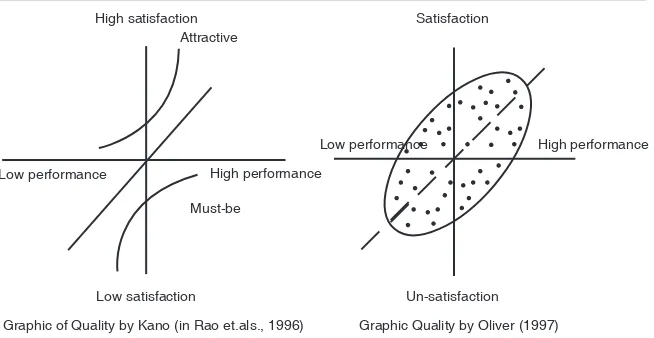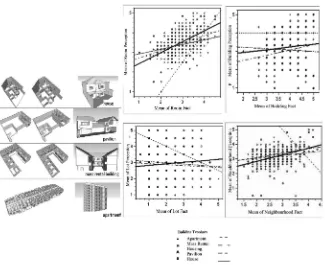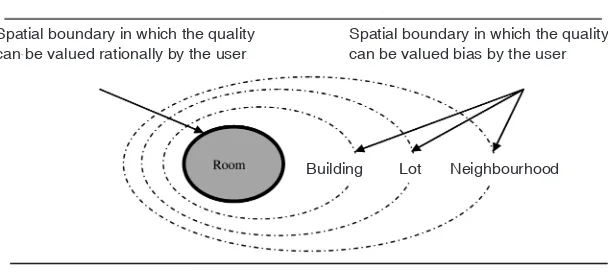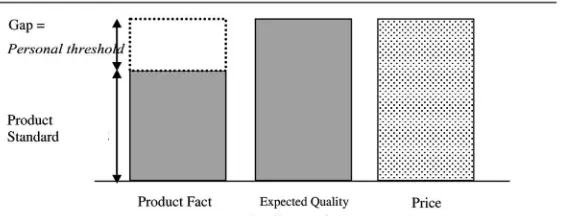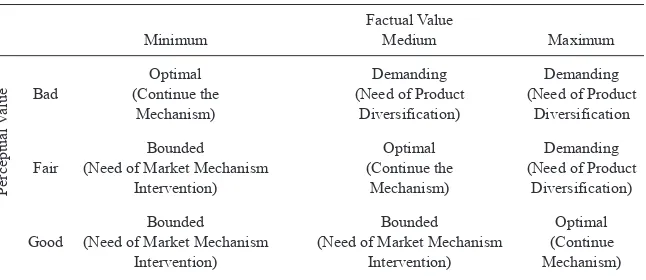ConSumer of rental houSing in
Bandung, indoneSia
Allis Nurdini & Ismet Belgawan Harun
School of Architecture, Planning and Policy Development, Housing and Settlement Research Group,
Institut Teknologi Bandung, Indonesia [email protected], [email protected]
ABSTRACT
The availability of choices for housing in different life phases is essential. The critical valuation from consumers becomes instrument to the quality control of housing supplied by producers. However, some consumers like students have unique characteristics, which potentially bound their housing choices. This paper describes the spatial bounded-choice phenomena from the situation of the students’ behaviour in Bandung, Indonesia as a Case Study. The factual and perceptual conditions of the students’ rental housing situated around the university in Bandung; the conditions of the housing choice; the factors which bound the student’s housing choice; and the formulation strategies of intervention to overcome the bounding factors are explored.
© 2012 cE-Bs, FAPS, UiTM. All rights reserved.
58
introduCtion
Housing as one of the basic needs for everyone closely related to the human life cycle, is traditionally divided into five stages : 1) bachelorhood phase, where young people leave the parents, 2) honeymoon phase, where young couples begin to find a family, 3) parenthood phase, where the family has a child, 4) post parenthood phase, where the older couples are living independently without their children, and 5) dissolution phase, where one of the elderly couple becomes a widow or widower (Schiffman and Kanuk, 1991). As housing is a basic need the choice of occupancy for individuals or families in each different phase is absolutely necessary.
The choice is the result of a process of thinking and decision-making of a number of alternatives, to get a rational decision. The choice in the context of moral is related to autonomy, freedom and responsibility of every individual or family (Brown and King, 2005). The barriers experienced by individuals or families in the selection of housing, potentially hinder their roles and responsibilities to maintain the quality of the space they use. The availability of the housing choice is the right that puts consumers as decision makers equivalent to the providers in market transaction. Conformity between aspirations of users with rental housing products is an indicator of the success of market mechanisms in meeting consumer demand of housing (Rugg and Burrows, 1999), and an indicator of the success of space design (Rapoport, 2001). Rational consumers will choose good quality housing and leave the poor quality ones, so that an increase of product quality by the producers can maintain sustainability.
rental houSing ChoiCe and potential Student’S Behaviour aS ConSumerS
Rental housing can be defined as a residential with rent status in all or parts of its unit. From the viewpoint of the user’s needs, the property is rented due to a few things: 1) no ability to own a house yet (problem of home ownership), 2) need to live in non-permanent housing for a certain period at a certain location (Kemp and Keoghan, 2001; Ozaki in Bartlett, 2002), and 3) preference for renting rather than buying (Kenyon and Heath, 2001). Rental housing for students include the second category, namely the need for a relatively short amount of time in housing in certain locations as part of the life-cycle of young people, who are entering the phase of leaving their parents’ houses because of education (Rugg and Burrows, 1999; Amole, 2011).
59
the limitation of the flow of information between providers and consumers (Aboody and Lev, 2000; Izquierdo and Izquierdo, 2007; Birchler and Monika, 2007); and the limitations of internal students as consumers (Rugg and Burrows, 1999; Rugg, Rhodes and Jones, 2002). In market mechanisms, the ability of students as consumers in assessing the quality of the rental housing is required for a balance transaction between consumers and providers. Comparison between the results of the factual assessment and perceptual assessment provide description about the choice behaviour of students as consumers of rental housing. The relationship between factual quality and perceptual quality (expressed by the level of satisfaction) is described by Kano (in Rao et al., 1996) and Oliver (1997) in the form of a graph (Figure 1). The horizontal axis states the facts of the range of product or specific product characteristics, while the vertical axis states the level of consumer perception of the product. Some characteristics of the product belongs to the category of required and available (must-be) for consumers. The condition of the quality is drawn by Kano graphic (Figure 1) in the form of a curved line starting from the bottom-left to the bottom-right.
According to Oliver (1997), the relationship between the fact and perception of the quality is expected to occur as an illustration of scatter-plot in Figure 1 (at the right side), where the higher the fact of a product, the higher the perception of customers’ satisfaction and vice versa. The condition indicates ‘optimal choice’ of consumers. However, Oliver gives notes on two conditions of anomalies of the relationship between the facts of the product and the perception of users: 1) Satisfaction with low quality, can occur when the critical power or expectations of consumers is low, while the performance of products can meet the expectations; and 2) Dissatisfaction with high quality can occur when critical
figure 1: Comparison of factual quality and perceptual one
High satisfaction Attractive
Must-be
Low satisfaction
Graphic of Quality by Kano (in Rao et.als., 1996) Graphic Quality by Oliver (1997) Low performance High performance
Low performance High performance Satisfaction
60
power or expectations of consumers is higher than the performance of products in the normal (default) condition.
Optimal choice requires three elements: 1) set of alternatives to choose for every individual, 2) knowledge and information that allows individuals to estimate the consequences of various alternatives, and 3) ability for determining the range of the consequences of what they like (Savage, 1954, in Gigerenzer and Selten, 2002). The condition in which the consumer is satisfied with the low quality is part of the phenomenon of ‘bounded choice’, derived from the theory of bounded rationality. The condition of consumers who experience bounded rationality was first stated by Simon (1957). He started the theory of bounded rationality with a statement that the decision making is the process of search, not the process of being completed/completeness (as assumed by the theory of rational choice) at one time, because it really depends on the level of aspiration to find diverse alternatives that they think is most satisfactory.
CaSe Study: Student’S ChoiCe Behaviour related to rental houSing
This research is conducted using two approaches: factual and perception based. The factual approach is an objective way to analyse the condition of the rental housing that reflects the capacity of providers in responding to the housing rental demand around campus. Meanwhile, the perceptual approach is a way to analyse consumers’ perception (using students as case study) regarding the quality of rental housing. The unit of analysis in this study is student rental housing. Data of the facts and information of the rental housing attributes are obtained by distributing questionnaires to students, direct observations on student housing, and multistage cluster sampling frame in five cluster campuses that have the highest accumulation of student population in the city of Bandung, including: Cikutra, Dipatiukur, Institute of Technology Bandung (ITB), University of Parahyangan (UNPAR), and Indonesia Education University (UPI) with a total number of 433 respondents who are students.
61
rental housing was a building (43.27%). 40.81% was a house, and the rest of them stayed in the pavilion and apartment.
The physical attributes of the students’ rental housing are detailed from each element of room, building, lot, and neighbourhood. The attributes of the room, building and lot involve space that is produced according to the supplier’s capacity, while for the neighbourhood, it is the space outside the lot of the rental housing which is built collectively and not only by the supplier. The factual and perceptual conditions are arranged into a value scale starting from (1) for the lower value to (5) for the higher value for each of the housing attributes. The initial assumption in the analysis of the perception was that the increased quality of the housing attributes were positively correlated with the increased perception of quality attributes of occupancy by residents, and a decreased quality of housing attributes were positively correlated with the decreased perception of quality according to the occupants. The median values are found at the level of 50% (0.5) thus becoming the reference of determination, with less than 40% (< 0.4) meaning that the correlation is low (the average height of the gap facts and perceptions) and more than 60% (> 0.6) meaning a high correlation (the gap between fact and perception low). The total correlation between the perceptions of the occupancy condition attributes will be compared with any existing residential typology. This analysis is used to conclude whether there are differences among the factual assessment and perception assessment by the consumer for each typology of the existing rental housing. The optimal choice occurs when there is better factual condition of the rental housing, with a higher satisfaction level from students as their consumers, called positive correlations. The results of the analysis are as seen in Figure 2.
62
the optimum choice conditions can be achieved in the room, where apartments get the highest value of correlation for all the attributes.
diSCuSSion: Spatial Bounded ChoiCeS Surrounding ConSumerS of rental houSing
From the comparisons of the factual and perceptual analyses, it can be inferred that the choice condition of students as consumers can be distinguished into three: optimal, bounded and demanding choices. Research on the case study results show that there is a continuum relationship between the optimum choice and bounded choice according to the factor of the spatial and non-spatial concerns of consumers. When choosing rental housing, students as the consumers are quite critical in assessing the quality of the rooms, but face a lot of trouble to assess the quality of the building, lot and its surrounding neighbourhood attributes. Thus they decide to live in the area although they are unable to assess the building, lot and neighbourhood. Figure 3 shows the illustration of the condition of the bounded choice in spatial boundary.
63
Because of the limitations of the consumer assessment for the quality of the building, lot and neighbourhood attributes, the intervention on rental housing is especially needed for the third sphere. Intervention in the sphere of the building and lot can be done through the provision of spatial setting built by the provider of the rental housing, while the intervention in the sphere of the neighbourhood can be done by setting up the infrastructure of the settlements around campus involving the rental housing provider and related community. The results also showed that bounded choice primarily occurred for students who lived in the building of mass rental housing, compared to the other types. The availability of the housing design influenced the choice conditions of the consumers. The typology of the mass rental housing was relatively widely available but did not yet satisfy customers, while customers were experiencing barriers to moving and pushing the condition of the bounded choice. In addition, the condition of the room-building-as a manifestation of unity with the lot/parcel forming mass rental housing, encouraged consumers in difficult situations to demand for a change in quality in a short time and choose to tolerate the un-met residential quality. Along with this, due to the number of products being the highest in rental housing market at the moment, the mass rental housing needs to be fixed by means of the quality attributes, incentives and disincentive stimulants from the local Government to the provider, as well as the application of regulations which can guarantee the need of consumers.
Moreover, it was also revealed that the economic affordability factor of the consumer affected the choice condition in students as consumers of rental housing. Students with higher economic range could assess the quality of housing in a critical way, while students with lower economic affordability were less able to judge the quality of the housing in a critical way. Therefore, the intervention of market mechanisms required for students was for those with lower economic affordability, especially with the availability of information of the housing quality related to the price, rental housing subsidy/allowance for students, and
figure 3: Bounded Choice in spatial context of rental housing Spatial boundary in which the quality
can be valued rationally by the user
Spatial boundary in which the quality can be valued bias by the user
64
provision of minimum spatial quality for students’ rental housing. The existence of the personal threshold/ personal standard in rental housing consumer was also revealed. Students who had higher economic affordability were capable of delivering quality demands such as a ‘more’ higher standard of quality, especially those who lived in apartment typology. Consumers assessed the quality of the space which has not been satisfying included that in their paid unit. This condition is a challenge for the designer to create a differentiation in the rental housing design that can meet with this consumer segment. Illustration on the personal threshold of this housing product can be seen in Figure 4. Meanwhile, students with lower economic affordability, tended to minimise the building quality thresholds especially for lot and neighbourhood attributes in the typology of mass rental housing. Although they had minimal condition of the dwelling fact, they found it difficult to get quality occupancy more than that, thus they accepted the conditions of the housing, instead of moving to a better housing quality.
figure 4: Gaps between housing factual products and expected quality by consumers
ConCluSion
Comparing the factual analysis and perceptual analysis provided two representations: 1) conditions of the consumer choice of rental housing, and 2) rental housing conditions which were in a satisfactory or bad quality. The condition of the consumer choice could be grouped into three categories: a. Optimum choice, b. Bounded choice, and c. Demanding choice. The optimum choice occurred when rental housing attributed with a high/maximum factual performance was valued by the consumer in high quality; and in a similar way the housing with low/minimum factual performance was valued by the consumer in a bad quality. Meanwhile, the bounded choice occurred when the housing with minimum factual performance was valued in a high quality/satisfied quality by the consumer.
65
achieve the maximum quality condition of housing (maximising). Demanding the choice happened when the housing was factually high/maximum performance but was rated badly by the consumer. This indicated the existence demanding behaviour for a higher quality of beyond the normal product. The last condition is categorised as a critical attitude of consumers to get a better quality of housing. The illustration of the results of the comparison of the factual value and perceptual one on rental housing is in Table 1.
Perceptual
V
alue
table 1: Matrix of consumer choice condition
Factual Value
Minimum Medium Maximum
Optimal Demanding Demanding
Bad (Continue the (Need of Product (Need of Product
Mechanism) Diversification) Diversification
Bounded Optimal Demanding
Fair (Need of Market Mechanism (Continue the (Need of Product
Intervention) Mechanism) Diversification)
Bounded Bounded Optimal
Good (Need of Market Mechanism (Need of Market Mechanism (Continue
Intervention) Intervention) Mechanism)
The existence of the optimal choice for consumers showed that the process of rental housing accommodation through on going market mechanism (without the intervention of other parties such as Government or colleges) has occurred. The conditions of the bounded choice indicated there has been constraint and need of correction or intervention in the market of rental housing. Rental housing, which has factual attributes in minimal conditions but is valued as good by the consumer, can happen due to two possibilities: 1 consumers accept or tolerate the lack of attributes, and 2) occurrence of various constraints that cannot be resolved by consumers themselves. In order to benefit the consumers of the rental housing, security in a competitive market, residential property and mechanism of transaction that cause the consumer to be bounded is needed to be intervened. Intervention against housing, housing design attributes and the mechanism of transaction need to be done to meet the needs of the consumers.
referenCeS
Aboody, D. & Lev, B. (2000). Information Asymmetry, R&D, and Insider Gains. Journal of Finance, 55(6): 2747-2766.
66
Bartlett, K., Potter, M., Meikle, J., Duffy, F., Ozaki, R., Hakes, J., Young, R. & Hooper, A. (2002). Consumer Choice in Housing, Joseph Rowntree Foundation: York Publishing Services Ltd.
Birchler, U. & Monika, B. (2007). Information Economics. London: Routledge.
Brown, T & King, P. (2005). The Power to Choose: Effective Choice and Housing Policy. European Journal of Housing Policy, 5(1): 59-70.
Gigerenzer, G. & Selten, R., eds. (2002). Bounded Rationality: The Adaptive Toolbox. London: MIT Press.
Izquierdo, S.S. & Izquierdo, L.R. (2007). The impact of quality uncertainty without asymmetric information on market efficiency. Journal of Business Research, 60(8): 858-873.
Kenyon, E. & Heath, S. (2001). Young adults and shared household living: Achieving independence through the (re)negotiation of peer relationships. Youth, Citizenship and Empowerment, 110.
Kemp, P.A & Keoghan, M. (2001). Movement into and out of the private rental sector in England. Housing Studies, 16(1): 1-37.
Oliver, R.L. (1997). Satisfaction: a Behavioral Perspective on the Consumer. New York: McGraw Hill.
Ozaki, R. in Bartlett, K. (2002). Consumer Choice in Housing. Joseph Rowntree Foundation: York Publishing Services Ltd.
Rao, A., Carr, L.P., Ismael, D., Kopp, R.J., Martin, J., Farshad, R. & Schlesinger, P.F. (1996). Total Quality Management: A Cross Functional Perspective. New York: John Wiley and Sons.
Rapoport, A. (2001). Theory, Culture and Housing, Housing Theory and Society, 17(4): 145-175.
Rugg, J. & Burrows, R. (1999). Setting the context: young people, housing and social policy. Young People,Housing and Social Policy, 1, 1-11.
Rugg, J., Rhodes, D., & Jones, A. (2002). Studying a Niche Market: UK Students and the Private Rented Sector. Housing Studies, 17(2): 289-301.
Schiffman, L.G. & Kanuk, L.L. (1991). Consumer Behavior. New Jersey: Pearson International Edition.
